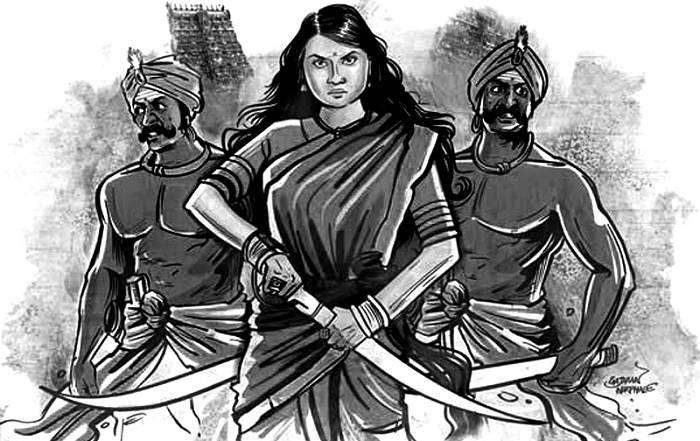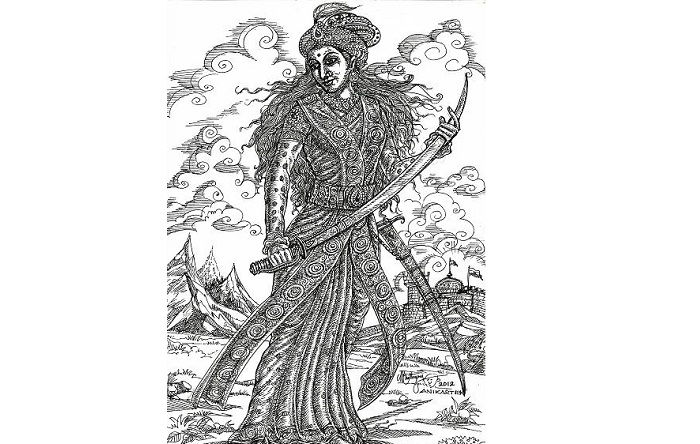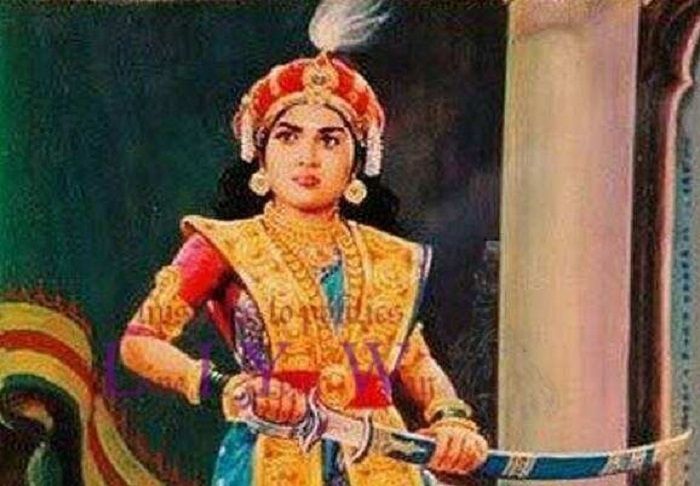Fast Facts
Date of Birth: January 3, 1730
Place of Birth: Ramanathapuram, Tamil Nadu, India
Parents: Muthathal Nachiyar(Father), Chellamuthu Sethupathy (Mother)
Daughter: Vellacci
Death: December 25, 1796
Place of Death: Sivaganga, Tamil Nadu, India
Movement: Indian Independence Movement
Rani Velu Nachiyar was a queen of Sivaganga estate in South India. She is regarded as the first queen who fought against the British colonial power in India. Born as princess of Ramanathapuram she took training in handling different weapons, in martial arts, horse riding and archery, and was also proficient in languages like English, French and Urdu. She was married to King of Sivagangai, Muthuvaduganathaperiya Udaiyathevar. After the British soldiers and son of Nawab of Arcot conquered Sivaganga and killed her husband, she fled with her daughter and lived at Virupachi under the protection of Palayakaarar Kopaala Naayakkar, build her army and joined hands with Gopala Nayaker and Sultan Hyder Ali to wage war against the British and regained her kingdom. She is also credited as the first person to apply human bomb.

Image Credit :https://madrascourier.com/wp-content/uploads/2018/02/Velu-Nachiar-Madras-Courier-02-1.jpg
Early Life
Velu Nachiyar was born on January 3, 1730, in Ramanathapuram, Tamil Nadu, India, in the family of Raja Chellamuthu Vijayaragunatha Sethupathy of the Ramnad kingdom and his wife, Rani Sakandhimuthal, as their only child. Sans any male heir, the royal couple raised the princess as a boy, who was trained in using war match weapons. She was also well-trained in archery, horse riding, Silambam (fighting with stick) and in martial arts such as Valari. A scholar in her own right, Nachiyar also had command over several languages, including English, French and Urdu.
At the age of 16, she was married to Muthuvadugananthur Udaiyathevar, son of the King of Sivagangai, Sasivarna Periya Udaya. Since 1730, Muthuvadugananthur Udaiyathevar was in charge of the administration of Sivagangai, the first independent state from Ramnad, while his father ruled as the King. Muthuvadugananthur Udaiyathevar became the King of Sivagangai in 1750 and emerged as the only ruler of Sivangangi to rule the state for the longest period of time, for over two decades till his death in 1772. Nachiyar and Muthuvadugananthur Udaiyathevar had a daughter together named Vellachi.
Struggle Against the British Rule
Sivagangai was invaded by the troops of the East India Company in association with the son of the Nawab of Arcot in 1772. Muthuvadugananthur Udaiyathevar was killed in a subsequent battle (the Kalaiyar Koil war) with Col.Smith. The war didn’t even spare women and children, many of whom were killed mercilessly marking one of the most ruthless incidents of those times. Some of the notable people including the trustworthy Marudhu brothers and Thandavaraya Pillai managed to escape the war. Nachiyar was in Kollangudi at that time. Following the death of her husband in the battle, she fled with her daughter to Virupachi near Dindigul, where she took refuge for eight years under the protection of Palayakaarar Kopaala Naayakkar.
During her stay in Virupachi, she gradually built a powerful army to fight against the British. In her mission she garnered considerable support from Gopala Nayaker and Hyder Ali, the Sultan and the de facto ruler of the Kingdom of Mysore in southern India. Seeking his help, she met the latter in Dindugal. As she conversed with him in Urdu, the queen highly impressed Sultan Hyder Ali with her resolute and courageousness. The Sultan gave his word to support the queen in her crusade to retrieve her kingdom. She was also allowed to stay at Virupakshi or Dindugal Fort by the Sultan where she was revered and treated as a Royal Queen. A monthly financial support of 400 pound (Gold) was also sent to her by the Sultan. She sought 5000 infantry and 5000 cavalry from the Sultan to fight the British, and kept on confusing her enemy by frequently changing her base. Sultan Hyder Ali also equipped her with necessary weapons so that she could put up a tough fight against the British.

Image Credit : https://anikartick.blogspot.com/2012/07/velu-nachiar-warrior-queen-and-freedom.html
In 1780, she came face-to-face with the British, and with this became the first queen in India to fight for freedom against the British. She came to know about the ammunition store of the British. With this information, the gallant queen, known by Tamils as Veeramangai, (“brave woman”) then plotted and arranged a suicide attack into the ammunition store. An army commander and a loyal follower of the queen, Kuyili, came forward to carry out the mission. Kuyili drenched herself with ghee and then set herself on fire before jumping into armoury and blowing it up, thereby procuring a victory for the queen. Kuyili, who many consider as an adoptive daughter of Nachiyar, is regarded as the first woman suicide bomber.
Nachiyar also had an adopted daughter, Udaiyaal, who gave her life detonating a British arsenal. The queen built up a woman’s army and named it ‘udaiyaal’ after her adopted daughter. After recapturing the Sivaganga estate, Nachiyar ruled the kingdom for the next decade while making her daughter Vellacci the heir to the throne. In 1780, she also bestowed powers to the Marudu brothers to administer the country. Following the restoration of her kingdom, Nachiyar expressed her deep gratitude for the support given by Sultan Hyder Ali by constructing a Mosque and Church at Saragani. The Sultan earlier conveyed his true friendship by building a temple inside his palace. Nachiyar also maintained good relation with Tipu Sultan, the son of Hyder Ali, whom she considered as a brother. She sent Tipu Sultan a golden tiger as a gift. Nachiyar’s daughter Vellacci succeeded her to the throne in 1790 as the second queen of Sivaganga estate and ruled till 1793.
Nachiyar, the valiant queen breathed her last on December 25, 1796, at the age of 66 years in Sivaganga, Tamil Nadu, India. According to sources, the queen was suffering from heart ailments in the last few years of her life and also underwent treatment in France. Her last rites were performed by her son-in-law.

Image Credit https://tamil.samayam.com/photogallery/news/history-of-velu-nachiyar/photoshow/62350905.cms
In Popular Culture
A commemorative stamp was released in her name on December 31, 2008. A Grand Dance Ballet presented by OVM Dance Academy of Chennai titled ‘VELU NACHIYAR’ narrates the epic story of Nachiyar.
Former Chief Minister of Tamil Nadu, late Jayaram Jayalalithaa on July 18, 2014, inaugurated the Veeramangai Velu Nachiyar Memorial in Sivagangai through video conferencing. A six-foot bronze statue of the queen was also unveiled by Jayalalithaa, who also announced that January 3 will be commemorated annually as the birth anniversary of the courageous queen.
Tamil-American hip-hop artist Professor A.L.I. dedicated a song titled ‘Our Queen’ to her as part of the artist’s album called ‘Tamilmatic’.
The life of Nachiyar, the first queen of India who fought the British decades before the celebrated Rani of Jhansi, Lakshmibai, was depicted in a grand dance ballet. The director of the ballet Sriram Sharma researched on the epic life of this brave queen for about a decade. It was performed in Naradha Gana Sabha in Chennai on August 21, 2017, and then in Mumbai on September 9 and in Delhi on September 21, 2017.


